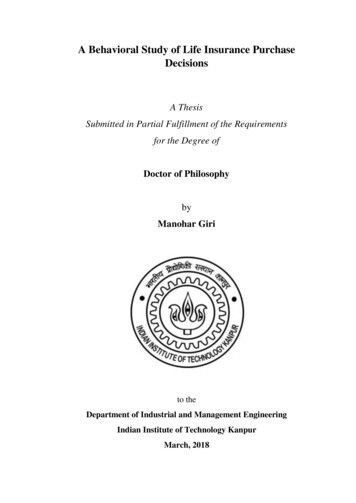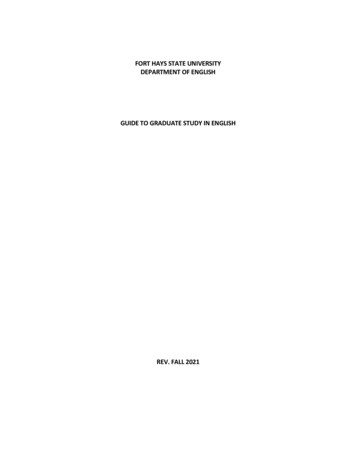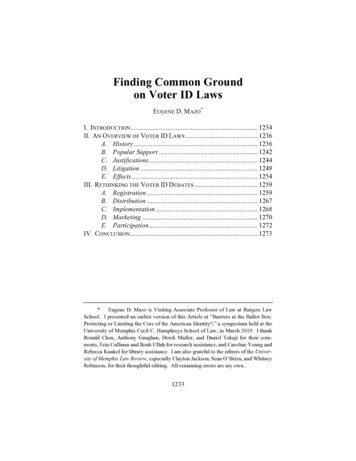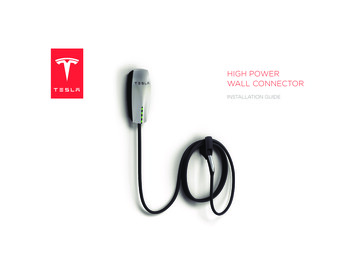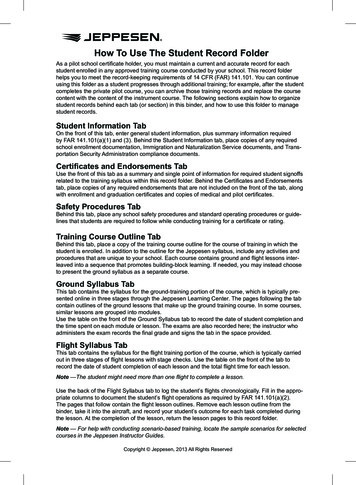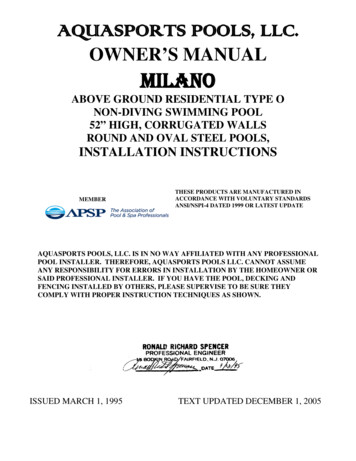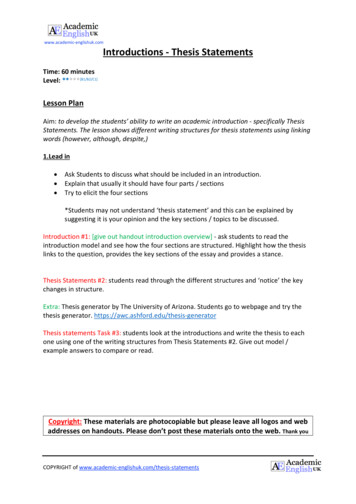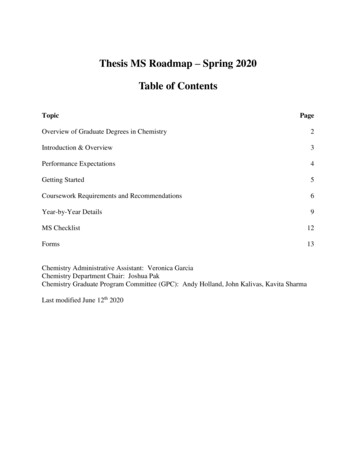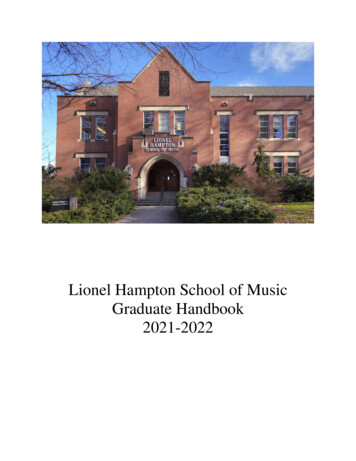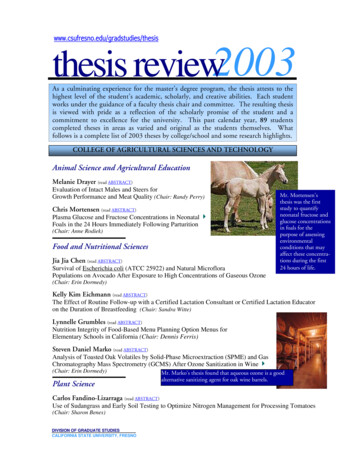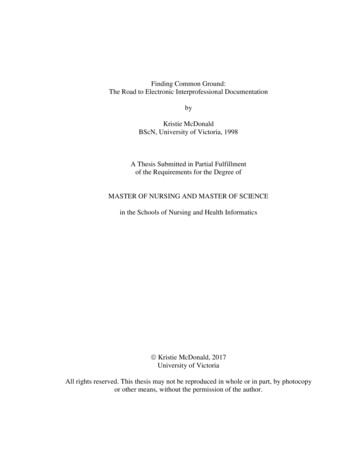
Transcription
Finding Common Ground:The Road to Electronic Interprofessional DocumentationbyKristie McDonaldBScN, University of Victoria, 1998A Thesis Submitted in Partial Fulfillmentof the Requirements for the Degree ofMASTER OF NURSING AND MASTER OF SCIENCEin the Schools of Nursing and Health Informatics Kristie McDonald, 2017University of VictoriaAll rights reserved. This thesis may not be reproduced in whole or in part, by photocopyor other means, without the permission of the author.
iiSupervisory CommitteeFinding Common Ground:The Road to Electronic Interprofessional DocumentationbyKristie McDonaldBScN, University of Victoria, 1998Supervisory CommitteeDr. Noreen Frisch, (School of Nursing)Co-SupervisorDr. Karen Courtney (School of Health Information Science)Co-Supervisor
iiiAbstractSupervisory CommitteeDr. Noreen Frisch, (School of Nursing)Co-SupervisorDr. Karen Courtney (School of Health Information Science)Co-SupervisorThis thesis portrays a research study undertaken to explore the unknown concept ofelectronic interprofessional documentation. Academic literature largely centers onmultidisciplinary electronic documentation yet clinicians provide care using an integratedinterprofessional model. Current design of electronic health records (EHRs) continue topropagate a deluge of data resulting from disparate siloed documentation. End usersreport challenges with finding data. Additionally, care planning and decision making aredelayed. To bridge the gap between electronic design and interprofessional delivery ofcare, more understanding of shared documentation is required. The provenance of thedesign of this study is based on the concept of common ground and the framework forcomplex diverse data. Common ground is a shared communication space within a teamwith a shared purpose (Cioffi, Wilkes, Cummings, Warne, & Harrison, 2010). Theframework for complex diverse data posits that data must be linked to otherinterconnected data; linked data enables connection of diverse pieces and insight-sharingwithin a team. A descriptive qualitative study was designed to answer the researchquestion: What are the common data elements between disciplines? A case scenario of apatient with a fractured hip was created; participants generated clinical notes based on thevideo and patient record. The clinical notes were coded and results indicated numerousdiverse common data elements. These were analyzed and major findings such ascategories appropriate for use by all disciplines on admission and design implications forcare planning throughout an acute care stay were identified. Further, as disciplines andcare team members do have different documentation patterns, it is suggested attendanceto differences in the entry of data yet maintaining a common ground in the display ofpatient information is vital. Finally suggestions such as duplicate checking fordocumentation through a common care plan that tracks assessments and completed
ivinterventions alongside planned interventions are made. Creation of a standardizedinterprofessional terminology is key in building the road leading to interprofessionalelectronic documentation.
vTable of ContentsSupervisory Committee . iiAbstract . iiiTable of Contents . vList of Tables . viiList of Figures . viiiAcknowledgments. ixDedication . xiChapter 1 Introduction . 1Background . 2Chapter 2 A Synopsis of the Literature. 10Data Sources . 10Literature Review Methods. 11Literature Review Results . 11Literature Review Discussion . 12Themes from Literature Review . 13Literature Review Summary . 35Chapter 3 Creation of the Simulation Using a Case Scenario . 37Case Scenario . 37Creation of the Video . 38Creation of the Textual Patient Record . 40Chapter 4 Methodology . 41Design . 41Ethics. 41Sampling . 43Recruitment . 43Data Collection Instrument . 46Data Analysis (Case Scenario). 51Data Analysis (Participant Characteristics and Opinions) . 57Chapter 5 Report of Findings . 58Coding of Case Scenario: Analysis . 58Study Results . 65Summary of Common Data Elements: Analysis of Case Scenario Coding . 108Coding of Case Scenario: Additional Findings . 109Results of Participant Characteristic and Opinions . 113Chapter 6 Discussion . 117Literature review updates . 118Significant Findings . 118Common data elements. . 118Documentation patterns within different teams, disciplines, and participants . 128Discussion of the Study Design . 132Limitations of the study design. . 132Use of simulation. . 136Future studies . 138
viIn Summary . 141References . 142Appendix A Articles Allied Health, Groups of Disciplines and Individuals . 155Appendix B Summary of Standardized Taxonomies Created by Multiple Disciplines 156Appendix C Case Scenario . 158Appendix D Script for Recorded Patient Simulation . 163Appendix E Actor Consent Form . 169Appendix F Videotaped Patient Scenario . 171Appendix G Patient Paper Record: Liaison Discharge Note . 172Appendix H Patient Paper Record: ED Note . 173Appendix I Patient Medication List . 177Appendix J Health Research Ethics Board Application . 178Appendix K Certificate of Ethical Approval . 228Appendix L Consent Form. 229Appendix M Introductory Email to Third Party Recruiters . 237Appendix N Invitation to participate . 238Appendix O Recruitment Poster . 241Appendix P Email with Consent Form (Consent Form found in Appendix L) . 242Appendix Q Participant Instructions . 243Appendix R Analysis Worksheet . 244Appendix S Codes and Code ID Numbers, Terms, and Data Elements . 245Appendix T Patterns of Documentation Unique to Each Discipline . 271
viiList of TablesTable 1 Summary of Source Types, Approaches, and Electronic vs Paper Processes . 12Table 2 Indication of Strength of Common Data Elements . 54Table 3 Numeric IDs for Categories, Subcategories and Single Data Elements . 64Table 4 Difficulties at Home: Challenges with IADLS Examples and Disciplines . 68Table 5 Difficulties at Home: Challenges with ADLs Examples and Disciplines . 70Table 6 Support System and Living at Risk Examples and Disciplines . 72Table 7 Lives in Home Apartment Examples and Disciplines . 75Table 8 Physical Assessment Examples and Disciplines . 81Table 9 Cognitive Delirium Assessment Examples and Disciplines . 85Table 10 Emotional Assessment Examples and Disciplines . 87Table 11 Medical History Examples and Disciplines . 91Table 12 History of Present Illness Examples and Disciplines . 94Table 13 Social History Examples and Disciplines . 95Table 14 Interventions: Planned Interventions Examples and Disciplines . 100Table 15 Interventions: Completed Interventions Examples and Disciplines . 103Table 16 Sources of Patient Information Examples and Disciplines . 105Table 17 Organization of Clinical Note Examples and Disciplines . 107Table 18 Total Common Data Elements by Indicator of Strength . 108Table 19 Data Represented by all but One Discipline . 110Table 20 Participant Characteristics: Disciplines . 114Table 21 Participant Characteristics: Years of Experience. 114Table 22 Participant Characteristics: Age. 114Table 23 Participant Characteristics: Gender . 114Table 24 Participant Opinions . 115
viiiList of FiguresFigure 1. Schematic of hierarchical relationships. . 61Figure 2. Schematic with colour and parent child classification. . 63Figure 3. Schematic of the category living situation. . 66Figure 4. Schematic of difficulties at home. . 67Figure 5. Schematic of difficulties at home. . 71Figure 6. Schematic of lives in home apartment. 74Figure 7. Schematic of the category assessments. . 77Figure 8. Schematic of musculoskeletal subcategory. . 79Figure 9. Schematic of physical assessment portion one. . 80Figure 10. Schematic of physical assessment portion two. . 81Figure 11. Schematic of cognitive delirium assessment. . 86Figure 12. Schematic of the category histories. . 89Figure 13. Schematic of medical history. . 91Figure 14. Schematic of the category interventions. 97Figure 15. Schematic of planned interventions. 100Figure 16. Schematic of completed interventions. 103Figure 17. Schematic of the category sources of patient information. . 106Figure 18. Schematic of the category organization of clinical notes. . 107
ixAcknowledgmentsI owe my deepest gratitude to a host of team members. My support network hasconsisted of numerous professional, personal, and academic individuals who have keptme motivated and on track. A big thanks to Gloria Bouchard for her support and belief inme and my colleagues who have grown with me in the world of nursing, informatics, andmajor initiatives; truly thankful for Island Health Authority for fostering a rich anddiverse career. Alongside professional growth, my friends and family have witnessedpersonal growth.To my friends, Heather, Lisa, Lance, Tanya, Rob, Mel, Scott, Skye, Carolyn andmany others—you have kept me laughing and provided balance in my life. Al andAdrienne—we have been figuring this out since orientation day .we did it!Mom and dad—you have always believed I could achieve higher academia andhave been my cheerleaders my whole life. Kim, Angelo, Kenny and Catherine, eventhough I will always be the ‘big’ sister, your love and patience over the years have beensteadfast and true. Nana and papa, I love you with my whole heart and have always beenthankful for the legacy of wisdom and perseverance you have instilled in all of us.Uncles, aunts, cousins—I am among many great minds and kind hearts.Thank you to both Noreen Frisch and Karen Courtney. You have openly sharedyour knowledge, experiences, and wisdom and have gently nudged me along the way.Our discussions and your feedback have helped me sharpened my focus; without yourguidance, I never would have been able to pull it off!
xFinally, Peter, I never would have made my way through this six year journeywithout you by my side. Your everlasting patience, physical and emotional support, andlove have truly kept me going. Thank you, and looking forward to many new adventures.
xiDedicationI dedicate this thesis to my nieces Kamila, Abby, Christina, and Kaity. I hope yougrow in the knowledge that you are important in this world; work hard, play hard, and bekind to all. Do your homework, listen to your parents, and eat your fruit and veggies.We have many more magic mystery tours coming up now that auntie has finished herhomework so strap on your running shoes and play clothes! Let’s go exploring.
1Chapter 1IntroductionInformation and communication technology (ICT) has changed the way Canadians shareinformation, study, interact, and conduct business (Canada Nurses Association, 2006). Indeed,digital information is used to manage finances, pay bills, customize musical playlists, and bookflights; it has become a way of life (Ball & Gold, 2006). Aligning with everyday life, there is amajor move to integrate ICT into healthcare (Finkelman, 2013). Subsequently, ICT tools, suchas the electronic health record (EHR), have been created. An EHR is an electronic longitudinalpatient record of health information created through encounters in a care delivery setting(HIMSS, 2014). The EHR enables healthcare professionals to document and access patientinformation, communicate, and make decisions (Hripcsak, Vawdrey, Fred, & Bostwick; 2010).The benefits of an EHR are tough to argue. It is a secure patient-centered record, available to allappropriate care providers, comprised of information captured throughout the spectrum of care(Noah, 2011). Indeed, at the provincial level information management and technology is a keypriority (British Columbia Ministry of Health, 2014a). However, the design of an electronichealth record is a challenge as it requires alignment of complex clinical concepts. One suchconcept, interprofessional clinical documentation, has not been widely considered in EHRdesign. This is evidenced by the lack of academic literature on the topic ‘interprofessionalelectronic documentation’. This significant gap in knowledge warrants investigation throughresearch (Sultz & Young, 2013). A background discussion sets the stage for whyinterprofessional electronic documentation is a topic worthy of further work.
2BackgroundThe concept of interprofessional practice has been widely supported for many years (Ash& Miller, 2013; Bainbridge, Nasmith, Orchard, & Wood, 2010; Burzotta & Noble, 2011; Collegeof Health Disciplines, 2008; McLaney, Strathern, Johnson, & Allen-Ackley; 2010; Orchard,Curran, & Kabene, 2005). Defined as active involvement of different professionals learning with,from, and about each other, interprofessional practice involves cooperation, rather thancompetition, to gain mutual respect and shared knowledge/decision making (The McGillEducational Initiative on Interprofessional Collaboration, 2014). Team members exemplifyinterpersonal and communication skills, provide patient-centered and family-focused care, andpractice collaboratively (College of Health Disciplines, 2008). Additionally, partnered decisionmaking, acknowledging clear roles and responsibilities, skilled team functioning, and continuousquality improvement all improve the delivery of care.Interprofessional practice has proven to reduce error rates, improve health and quality oflife, and increase patient satisfaction (Ash & Miller, 2013). Canadian governing healthcarebodies at both a national and provincial level identify interprofessional care as a strategic priority(Health Canada, 2012; British Columbia Ministry of Health, 2014b). Indeed, national groupssuch as the Canadian Interprofessional Health Collaborative (CIHC) have been created to buildthe evidence base, result communication, and sustainability of interprofessional collaborativepractice (Health Canada, 2012). At an international level, bodies such as the British Departmentof Health who are committed to interprofessional documentation through a single assessmentprocess, prioritize the negation of duplicate documentation (Caldwell & Atwell, 2003).Supported from governing leadership, many teams function from an interprofessional model. It
3is important to understand how processes, such as interprofessional clinical documentation, canbe supported in an electronic environment.Since the period of Florence Nightingale, documentation of patient care has become afoundation of professional practice (Chelagat et al., 2013). Documentation reflects professionalprocesses, supports teamwork, and is a source for quality improvement and staff performancedata (Finkelman, 2013). Clinicians have a responsibility to document care planning, careprovided, and patient outcomes (Finkelman, 2013). Essential to governing bodies,documentation within the patient record protects patients, staff, and organisations from risk ofphysical and legal harm (Blair & Smith, 2012). Most importantly, clinical documentationdefines the patient; it is the embodiment of the patient story (Hripcsak, Vawdrey, Fred, &Bostwick, 2010). Void of the patient story, the EHR consists solely of demographics, diagnosticresults, and scheduled appointments; it would be of little benefit to interprofessional teams,governing bodies, and, ultimately, to patients. Knowing the patient story guides clinical decisionmaking thus enabling patient centered care (Chunchu, Mauksch, Ross, & Pauwels, 2012). Aspatient centered care requires effective and efficient sharing of patient information, clinicaldocumentation is the ‘vehicle’ to share knowledge (Mamykina, Vawdry, Stetson, Zheng, &Hripcsak, 2012). Sharing and seeking knowledge in order to deliver holistic comprehensive careis a key focus of interprofessional teams (Burzotta & Noble, 2011).Medical record-keeping is first noted in ancient Greek medical case histories Evolutionof medical records is founded in collections of diet and recipe advice, lessons learned fromautopsies and successful cures; they contained patient name, date, complaint, histories,diagnoses, therapy and payment (Kassell et al., 2015). They are all designed to collectinformation. Similarly, routed in the work of Nightingale, clinical documentation remains core
4to interprofessional practice for the nursing and allied health professions. In the realm ofelectronic clinical documentation, there is the ability to support interprofessional practicethrough a design that is reflective of professional work, care planning, legalities, and the patientstory. Unfortunately, designing an EHR that supports interprofessional documentation mustattend to multiple components within a complex healthcare system.All clinical processes occur within the context of a healthcare system comprised ofinteractive sociotechnical components (Sittig & Singh, 2010). For example, clinical contextinterconnects with hard/software infrastructure, human-computer interfaces, people, workflow/communication, internal culture/policies, external governance, and system evaluation (Sittig &Singh, 2010). During EHR design, if portions of these components are left unattended, clinicaldocumentation is negatively affected. This leads to poor adoption, increased error rates, andworkflow disruptions (Ammenwerth et al., 2002; Ash, Berg, & Coiera, 2004; & Borycki, 2010).Indeed, a poorly designed ICT, that is not holistic in nature, places patients at risk, negativelyaffects the healthcare system and, consequently, compromises the success of an ICT initiative(Meeks, Takian, Sittig, Singh, & Barber, 2014). In light of this, design of electronicinterprofessional documentation must account for all sociotechnical components. A look intocurrent knowledge reported in the literature about electronic interprofessional documentation isthe first step in appreciating other sociotechnical components.Using the boolean search term “electronic interprofessional documentation” in bothMedline and CINHAL databases, resulted in only one article. The article was the outcome of asystematic review of 26 articles on care pathways (Deneckere et al., 2012). Researchersconcluded a positive, but cautious, relationship with care pathways and interprofessionalpractice. Although this article shed some light on one possible electronic documentation
5component, care pathways, there is a disturbing lack of literature supporting interprofessionaldocumentation. Interprofessional care and clinical documentation are foundational processeswithin a healthcare system, yet the concept of ‘interprofessional documentation’ remainsvirtually non-existent. This speaks to a major knowledge gap in the field of health informatics.Arguably, this gap is reflective of significant flaws in current EHR design. Without knowing, orunderstanding a phenomenon such as interprofessional electronic documentation, current designsdo not support clinical practices. This is a foundational and key design flaw in records that arecurrently designed with a multidisciplinary care model and may be contributing to poor adoptionoften expressed in academic literature pertaining to electronic documentation. As much has beenwritten about electronic multidisciplinary documentation, a deeper look into the phenomenon ofdesign components of electronic interprofessional documentation may help illuminate currentknowledge influencing EHR design.Multidisciplinary care fosters collaborative, but largely independent work. Althoughpatient needs are often discussed, multidisciplinary team members address a particular portion ofpatient care (Ash & Miller, 2013). They often believe they are the most qualified to managepatient care and work in competition with others (Ash & Miller, 2013). They use differentlanguage sets, duplicate service, foster distrust and disrespect, and maintain dogmaticprofessional boundaries (Orchard, Curran, & Kabene, 2005). They ‘guard their own patch’(Sheenan, Robertson, & Ormond, 2007). As a direct result, patients are often asked the samequestions on multiple occasions. Subsequently, electronic multidisciplinary documentationcultivates redundant information (Caldwell & Atwal, 2003). Redundant information documentedin several sections of the patient record, buries unique, and possibly vital, data. Electronic
6documentation designed to meet the needs of a multidisciplinary team fosters siloed practice,communication, and, ultimately impacts decision making (Caldwell & Atwal, 2003).As the needs of a patient are beyond the expertise of any one discipline, removingbarriers such as organizational structure, power imbalances, and role socialization, will foster atrue appreciation for the overlap, complementary, and unique skillsets exemplified by teammember (Orchard, Curran, & Kabene, 2005). Unfortunately, as these barriers are verychallenging to overcome, multidisciplinary team work remains the norm for many workenvironments. As a result, the abundance of literature on multidisciplinary electronicdocumentation is the current unsettling reality in academic literature informing EHR design.Unfortunately, it may have contributed to another disturbing phenomenon: the data deluge.‘Drowning in data’ is a term coined by a group of researchers who argue that a deluge ofraw data and lists of isolated facts overwhelms clinicians (Leonardo, Resick, Bingman, &Strotmeyer, 2004). Poorly designed EHRs foster a rapid increase in volumes of data; this causesusers to search and filter through a disparate amount of information (Unerti et al., 2009). Thisinformation is often redundant and may be a direct result of siloed multidisciplinary processes.Steinberger et al., (2009) found information mismanagement often affect physician crosscoverage; abnormal lab results are buried among normal ones. Others identified that narrativenotes do not meet the needs of those reviewing and are largely unnecessary (Braaf et al., 2011).Further, narrative notes adversely affect other team members’ abilities to make timely andeffective decisions; vital information is lost in routine patient care documentation (Tornvall etal., 2008). Multidisciplinary documentation provides minimal context, is a burden to siftthrough, leads to information overload, and adversely affects decision making and patientoutcomes (Collins & Vawdrey, 2012; Steinberger, Douglas, & Kirschbaum, 2009). There is a
7high risk that continuing to disregard an interprofessional design, will propagate ineffective andharmful documentation processes. Identifying data obtained and used by each team member,including allied health (AH) professionals, is the first step in supporting interprofessionalpractice. Disturbingly, although AH members contribute a significant portion of patientinformation, they are poorly represented in academic literature pertaining to multidisciplinarydocumentation. AH team members such as physiotherapists, occupational therapists, socialworkers, dietitians, pharmacists and respiratory therapists, are integral to patient care. Despitethis, they are not well represented in current research. A search in CINAHL and Medline for
Creation of a standardized interprofessional terminology is key in building the road leading to interprofessional electronic documentation. v . me and my colleagues who have grown with me in the world of nursing, informatics, and major initiatives; truly thankful for Island Health Authority for fostering a rich and

